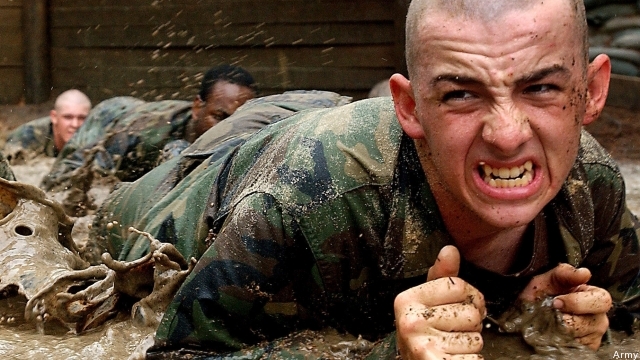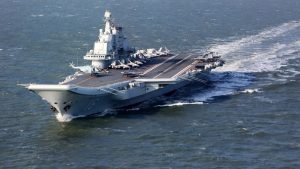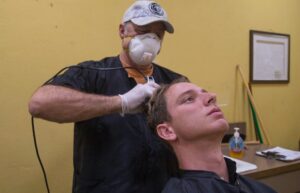
The military services cannot wait 12 to 18 months until a COVID-19 vaccine is developed and the population inoculated or immunized by infection because the damage to military readiness and America’s position in the world would be too great.
The services have paused recruit training, halted personnel transfers, cancelled most large training exercises, and forced staff to work remotely. Instead of that approach, the Pentagon needs to allow core military activities to continue while minimizing the risk to the force. These efforts can protect the force while still enabling the military to accomplish its mission.
The military services have largely paralleled civilian constraints.
Civilian communities across the country have shut down. All states have restricted gatherings and stopped on-site school classes. Many states have gone further, requiring non-emergency personnel to stay at home and citizens wear protective gear when outside.
The military services have copied many of these actions, wearing protective equipment, shutting down non-emergency activities, ceasing most unit training, freezing personnel at their current locations, educating remotely or not at all, and doing office work remotely.
But the military is not in a sustainable place.
These constraints may buy time to put other measures into place, but without recruit training, the services will lose .5 percent of their end strength every month (unless stop loss is imposed, and that has its own costs). Because the training pipeline is several months long, units will not feel that gap for several months, but when the pipeline begins to runs dry, units will shrink. That will continue for months after normal operations restart until the pipeline refills.
The “stop movement” order, recently extended until June 30, freezes personnel at their current stations. That’s tolerable for a short time but rapidly becomes a major problem. Military schools need to send this year’s cohort off to use their new skills and take in the next cohort for training and education. Personnel stationed overseas want to come home. Further, some families have been caught mid-move maintaining households in two locations.
Cancellation of training at levels higher than the individual or small unit is degrading readiness gradually but inexorably. The Air Forces’ Red Flag-Alaska training exercise for combat pilots was cancelled, while the Army’s Defender Europe 2020 division-level exercise was severely scaled back. Meanwhile, the Navy postponed to 2021 its long-planned Large Scale Exercise, which was designed as a first real test of maritime distributed operations.
At first this will be imperceptible as units live off accumulated skills and maintenance. With time, as personnel turn over, equipment breaks down, and skills atrophy, the effects will become more apparent. Soon, the accumulated damage will approximate what happened with sequestration in 2013. At that time, the military services had to stop much training and furlough civilian employees to save enough money to stay within the budget caps imposed by the Budget Control Act. Secretary of Defense Jim Mattis described the effects on military readiness as “shock[ing]” when he returned to the Pentagon four years after sequestration: “For all the heartache caused by the loss of our troops during these wars, no enemy in the field has done more to harm the readiness of our military than sequestration.”
Remote work has become commonplace across society, but it is not viable for many defense activities. The problem is classified data, which cannot be accessed on most home systems. Personnel can do what they can with unclassified material, and the government has set up separate systems for sensitive data. However, at some point senior officials need to make tough choices about force levels and acquisition programs. These decisions require a foundation of analysis that can only be done with classified material.
There have been murmurings that the military should go further and adopt the full set of shelter in place restrictions that the civilian community has adopted and reestablish its pattern of global engagement as the pandemic subsides. This notion is reinforced by forecasts of continuing waves of infection if social restrictions are lifted. As one highly influential paper concluded: “The major challenge of suppression is that this type of intensive intervention package… will need to be maintained until a vaccine becomes available (potentially 18 months or more) – given that we predict that transmission will quickly rebound if interventions are relaxed.”

Chinese aircraft carrier Liaoning recently sailed through Japan’s Miyako Strait & passed Guam while American nuclear carriers were in port.
But force protection cannot be the military’s top priority; the mission must come first, even if scaled back and modified. The world is not standing still. Potential adversaries―China, Russia, North Korea, Iran, terrorists―may not view the present crisis as a “timeout” from normal activities but as an opportunity. The effects of US disengagement from forward deployments was seen recently when the only operating carrier in the Western Pacific was Chinese. The Liaoning used the opportunity to sail near Taiwan and Okinawa, making the point to US allies that the Chinese were there, and the Americans were not.
Getting out of the readiness versus force protection dilemma. If a service is essential, it is possible to operate during a pandemic with protective measures. Home Depot has done it, Lowes has done it, and the neighborhood supermarkets have done it. The military can do it also, but it needs to take aggressive action.
Here are 10 steps that will, collectively, help reduce risk to an acceptable level and allow a sustainable amount of activity. An “acceptable level” is not zero but a level that could be tolerated for the 12 to 18 months until a vaccine is available and herd immunity acquired.
Test for infection. This one is obvious. DoD has recently announced a four-tiered system to test the force for COVID-19. The more testing that is available, the easier it will be to identify and isolate those who are infected and to track down their contacts. How important is testing? Do a thought experiment: if everyone could be tested every day, then the pandemic would be stamped out in short order by identifying and isolating the sick before they could infect others. Daily testing will not be achievable, but regular testing will be available soon. After testing the sick and suspect, DOD should give priority to those who must work in confined groups―for example, ship and air crews―so they can conduct something approaching normal operations.
Identify the immune. People who have had the virus have acquired some immunity — perhaps for a lifetime, perhaps for something less — but enough to get through the current emergency. These people do not need to take the precautions that others require and can work normally or something close to it. These are the people who can interact most closely with others and should be assigned to jobs that require personal contact.
Provide personal protection equipment (PPE) to everyone. Americans, indeed all global citizens, are getting used to wearing a mask and gloves when outside their houses. The military services need to apply this universally and enforce it (as they mostly do now). To be effective, this PPE will need to be changed daily and cleaned. Mass cleaning technologies are becoming available. Until then, the military should do what some hospitals do: give employees five masks that they rotate.
Testing for antibodies is the ideal approach. Although just beginning, this will be key in restarting not just military operations but the economy in general. Until a valid test is widely available, and that may take months, the services will need to use clinical assessments and even self-reporting to identify those who have had COVID-19. That’s not ideal, but it will serve. Someone needs to be on the front line of personnel contact, and those people should be the ones at lowest risk.

A new recruit with Bravo Company, 1st Recruit Training Battalion, receives his initial haircut during receiving at Marine Corps Recruit Depot, San Diego, March 30.
Some individuals who deal directly with large numbers of people will need more elaborate PPE― face masks and maybe suits or treated coveralls. This would allow some interaction-intensive activities to continue, for example, Marine Corps haircuts. The Marine Corps has been mocked for continuing to provide haircuts―a Marine Corps cultural touchstone. Rather than have a cultural showdown, barbers could continue their work but with elaborate protection since they inevitably touch a lot of people.
Keep working remotely wherever possible. Already widely employed, remote work will continue for a long time, even after something close to normal activities return. Indeed, some observers believe that remote work will become much more common across the entire society than before. Social distancing will also likely need to continue until a vaccine is available. That means no handshakes, no lines, no crowds.
Scrub the workplace daily. Coronavirus can survive for a period of time on surfaces, up to four hours on copper, a day on cardboard, and a few days on plastics and stainless steel. However, the virus is vulnerable to bleach, detergent, and disinfectants. Many retail establishments are already doing daily cleaning. Grocery chains around the country have reduced hours to allow additional cleaning, restocking, and help employees stay healthy. Military facilities will similarly need daily cleaning, with perhaps hourly cleaning of public surfaces such as countertops, access handles, and door knobs. Deep cleaning will be needed periodically. Much of this burden will fall on cleaning crews (the unsung heroes of the pandemic) who typically come through at night when the workforce has left. But everyone will need to participate. Every office should have a spray bottle of disinfectant and a frequently replaced rag so that personnel can clean their own spaces.
Start shift work. Shift work is common in manufacturing and some service industries but is unknown in most areas of the economy and in most military activities. Offices and work areas are typically open for one shift during the day, and everyone works at the same time. Yet, one obvious way to accomplish social distancing is to have people work at different times. One shift might run from 0530 to 1330, the second shift from 1330 to 2130. Maintenance and cleaning would operate from 2130 until 0530.
This will be inconvenient for everyone. The first shift will need to arise very early, the second shift will be up late. Maintenance and cleaning personnel would be up all night. It’s inefficient because the normal collaboration of the workforce will be disrupted. Yet it’s unavoidable because the easiest way to enforce social distancing is to not have a lot of people present in the first place. The intelligence community, for example, has already taken steps to incorporate shift work as part of its coronavirus response.
Pay extra attention to the most vulnerable. Risks are not evenly distributed. For those in their 20s, fatality rates are low, though not zero, about .2 percent of those infected. Fortunately, most military personnel are in this low risk category. However, some civilians who work with the military and some military personnel, especially in the senior ranks, are in age groups or medical categories that are more vulnerable. Perhaps they have diabetes, are immunosuppressed, or have a chronic lung condition. These personnel will need additional protections and maybe temporary assignments.
Screen daily for temperature and health. The military is already doing this widely and that will need to become universal. Everyone will need to have their temperature taken and be asked about their health and social contacts when they arrive for work. People in questionable categories can be taken aside for additional screening.
Stop large meetings. Sorry, Sergeant Major, but that means no mass formations, no assemblies in the auditorium, no large classes, no gaggles around the commander (and especially don’t gather everyone together to give them the word about these new procedures.) This will be inefficient; it’s much easier to pass information, give tests, and engage the unit at one time, but that’s just too risky in the current environment. Gatherings held for key training events, and they should be few, need to space the troops widely. This prohibition will also disrupt military culture, which uses large gatherings to recognize major events (changes of command) and accomplishments (promotions and awards). These will need to be done in small groups.
Isolate before deployment. For the 14 days before deployment, whether it is a ship or a ground unit, personnel should be screened and then isolated, so that anyone who is sick can be removed before embarkation. The military is already doing this, especially the Navy, but the practice will be need to become standard. The procedure is not perfect. Asymptomatic infected personnel can infect others while in isolation, but isolation provides a buffer. The buffer becomes stronger when widespread testing becomes available so that personnel can be certified as infection free when they go into isolation.
DoD needs to do something. The Defense Department, and other essential institutions in the society at large, are already taking many of these actions. They just need to be standardized and centrally directed.
These procedures will not reduce risk to zero. The discussions about mission versus force protection will be awkward because conversations about human risk always are. Some troops will still get sick. A few will die. But force protection is not the military’s primary goal; the mission is. Being in the military and defending the nation entail risk. These risks can be reduced to levels that allow sustainment of core military functions – basic training, skill training, small unit training, overseas deployments, nuclear alert, budget development, and operational planning.
In the end, the military services have no choice. Their core capabilities are deteriorating. They need to find ways to protect the force and continue operations in a COVID environment.
Mark Cancian, a member of the Breaking Defense Board of Contributors, was a Marine colonel and senior official at the Office of Management and Budget before he joined CSIS. Adam Saxton is a research associate at CSIS, where he supports research related to U.S. force structure, great power conflict, and the international order.
Senate passes $95 billion foreign aid bill, as DoD eyes next Ukraine weapons package
Additional aid for Ukraine could be made available “within days” said Pentagon Press Secretary Maj. Gen. Pat Ryder earlier today.


























